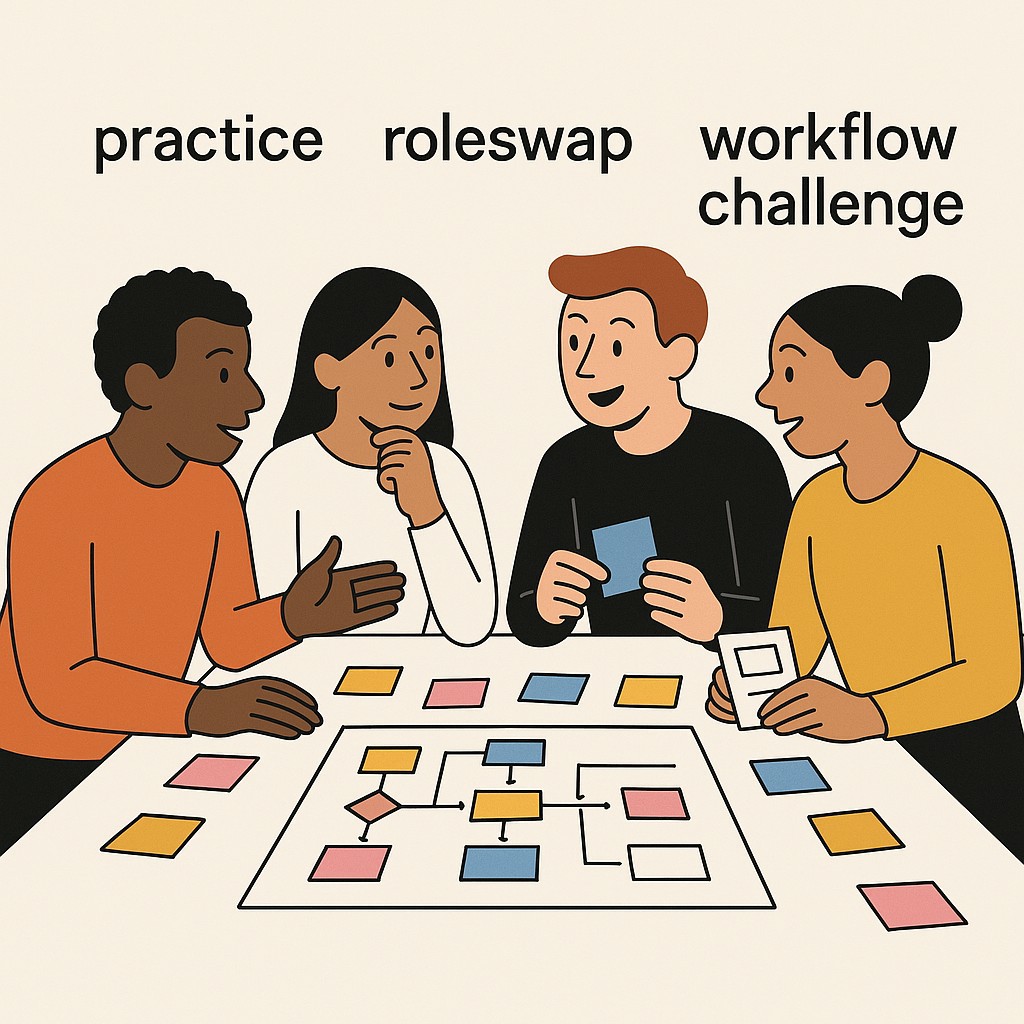Train Engineering Teams for Change: The Resilience Playbook
Train Engineering Teams for Change: The Resilience Playbook

How Repeated Exposure to Change Builds Real Resilience
I dropped out of college on purpose. That decision sent me straight into the Navy—a move that, at twenty, felt more like a naive leap than a calculated risk. Back then, I thought I was just taking the next right step, but in truth I was leaving behind the guardrails everyone else seemed to cling to. That one pivot led to jobs in places I couldn’t pronounce, careers that barely resembled the last, and routines I had to invent or discard with zero warning. I didn’t know better. If I’m honest, I barely knew myself. It didn’t build stability. It built resilience.
So when I see engineering managers and AI leads today scrambling to train engineering teams for change while rattled by surprise reorgs, missed targets, or new directives that pull the rug out, I recognize the look. There’s a default to freeze, to try to control every variable or wish it all away. But work optimized for predictability can’t handle this kind of constant change. Rigidity just grinds momentum to a halt.
Here’s a shift that changed how I lead: treat change like the baseline, not the exception. Change is not a surprise. It is guaranteed. The real trick is to train for it, not just prepare plans A, B, and C.
When I was younger—after that string of moves, several wild pivots, and enough false starts to lose count—I noticed something. Once you survive a few major pivots, future changes lose their power to intimidate. New chaos feels less like a threat, more like a different flavor of ordinary.
That’s the insight that flipped my approach to teams and projects. Everything becomes relative. When change is constant, you stop fearing it. You start building for it.
Why Planning for Uncertainty Works Better Than Resisting It
No matter how carefully we map a project or organize a team, the structure always shifts. Requirements evolve. Dependencies slip. People get promoted or move on. The core agile principles apply everywhere—most teams can learn them, but true mastery remains elusive, per Scrum Alliance. I’ve stopped expecting stability to last more than a sprint or two. It never does.
Some weeks, “change” is just a teammate leaving or a process breaking. Sometimes it’s bigger—a sudden reorg, surprise layoffs, or a full pivot in product strategy. Either flavor can knock teams off balance. They don’t always feel different in the day-to-day; sometimes the quiet changes do more damage than the loud ones.
Waiting for these disruptions to be declared is too slow. I now actively scan for early signals—roadmap churn, odd procurement delays, a shift in stakeholder tone, even tiny changes in micro-metrics. A light daily scan habit lets you spot patterns before surprises turn into emergencies.
I remember once, years ago, I misplaced my passport the night before a flight. When you live out of a suitcase and borders blur together, you get complacent about tracking the basics. I spent an hour tearing through bags and jacket pockets, rehearsing every recent move, until I found it wedged inside a paperback novel I hadn’t finished. All the planning in the world couldn’t prevent that last-minute scramble. That little fiasco did two things: it forced me to recognize how fast order can slip into chaos, and it made me triple-check the essentials every time after. Pattern-recognition isn’t just for code or org charts. Sometimes it’s about finding your bearings again in the noise.
If you’re feeling destabilized, that’s fixable. Next up is a practical framework any team can run this quarter—The Change Resilience Playbook—to make disruption not just survivable, but useful.
Five Practices to Train Engineering Teams for Change

Step one: Expect plans to break. Plan for breakage by writing plans designed to absorb shocks, not avoid them. If you set baseline agreements for how the team reacts when the plan shifts, pivots start to lose their sting. They feel normal, not catastrophic.
Step two: Scan for early signals. Pick three to five leading indicators—maybe roadmap churn, stakeholder priorities, or micro-metric oddities—and set a simple weekly ritual to review them. Pre-wired small course corrections let your team adapt before a curveball becomes a crisis.
Step three: Train engineering teams for change by running controlled drills on purpose. Once a quarter, swap owners on a live sprint, force a backlog shuffle under an artificial constraint, or simulate a vendor meltdown with a 30-minute role-play. Rotate on-call teammates using a playbook, not winging it. I keep doing this because after several major life moves—Navy, expat jobs, team pivots—I learned to make peace with plans breaking by training for it deliberately. Change feels survivable, sometimes even energizing, when you’ve built the muscle memory ahead of time instead of improvising in the moment.
Step four: Design with options, not certainties. If you rely on modular architecture, feature flags, dual-path roadmaps, and contingency branches, sudden pivots won’t mean scrap-and-rebuild. Just toggling the right switch. Running feature flags lets us swap out production code safely, lowering the friction and risk of sudden pivots. This way, adaptation becomes routine, not a huge headache.
Step five: Reframe outcomes after every change. When the team meets post-pivot, name the new opportunities just as intentionally as the costs—capacity freed up, faster feedback, tighter alignment. If you consciously name what each shakeup creates, not just what it costs, it recalibrates team agency and boosts motivation. #GrowthMindset
Practice these five habits regularly and you’ll build engineering resilience to change, with the fear of change fading into a kind of quiet readiness. That’s real resilience.
Turning The Playbook Into Daily Engineering Habits
When plans break—and they will—the trick is keeping the wheels turning instead of getting stuck in post-mortem mode. Tighten your team’s sprint goals to focus on the outcomes, not the process or the perfect solution. Keep a running options log to build team optionality. Every time something unravels, jot down two alternate routes the team can take. Then use decision windows—a set point in time when you pause just long enough to reconsider options, pivot if needed, but never slow delivery to a crawl. This makes shifting midstream feel less like failure, more like updating GPS directions when a road closes. #YourMove
You can see the next shift coming if you connect your dashboards to leading indicators—those small metrics and signals that change before the big status update. Host brief pre-mortems on risky bets, even if it feels redundant. Running a premortem up front improves projects proactively—identify risks before launch and avoid retroactive autopsies. So, for your top two initiatives, lead engineering through change by pre-committing to backup routes now. Even if you never use them, having contingencies out in the open lowers the temperature when a real pivot lands. #EngineeringLeadership
The real win, though, is in pivoting without scrapping what’s working. Sequence your roadmap in layers; imagine the core stack like the foundation, with features stacked on top so upstream strategy changes don’t ripple down and force a chain reaction of missed deadlines. I learned this the hard way building global platforms where a change in one market could trigger three languages to break and payment providers to disappear overnight. When your system is modular, you’re not rolling everything back. You’re just switching which layer is active. So next time the execs pivot or the customer requirements morph, your team flips the flag, reroutes, and keeps moving. That’s adapting without burning down the house.
After any big shift—new goals, new team, new market—block out fifteen minutes for an “opportunity scan.” This is not a feel-good exercise; it’s how you surface hidden wins. Publish what’s now possible: redeploy someone’s unused skills, chase a faster implementation path, trade a bloated feature for a sharper scope. Change always closes doors, but it opens a few, too. If you call those out fast, you turn “reactive mode” into proactive velocity. Try it next pivot, and watch your team move quicker—without the grumbling.
When priorities pivot, let our AI draft sprint summaries, release notes, and stakeholder updates in minutes, so you keep momentum, communicate clearly, and spend more time building.
Addressing Doubts, Investing in Real Resilience
Training for change can feel like a time sink—until you count the hours lost to thrash when teams flail through surprise pivots. Think of this as risk reduction, not extra overhead. The hours spent practicing for disruption save far more down the line, in missed fire drills and smoother recoveries.
Change fatigue and morale are real concerns. Here’s how to avoid them: run change reps for engineers with small, frequent exposures instead of letting pressure build, celebrate every micro-win, bake in recovery weeks when you push hard, and rotate who leads change drills so no one shoulders the brunt alone. I worried this approach might undermine long-term planning until I saw the opposite happen—morale ticked upward when people knew they were prepared, not just bracing for the next wave.
Change is not the enemy of leadership. It is the environment leadership was made for. Your calm, your curiosity, and putting options on the table first all shape how your team weathers strategy resets. Model that when the next shift hits.
Still, I’ll admit—even after years of building these habits, there are moments when a big curveball lands and my first reaction is to reach for control. I know I should default to options, but some part of me still searches for the certainty I left behind years ago. Maybe that’s never fully outgrown.
Run the playbook this quarter and track just three things: momentum regained, an earlier signal spotted, and an option taken that avoided a big rebuild. This is how resilience gets built—one practical move at a time.
Enjoyed this post? For more insights on engineering leadership, mindful productivity, and navigating the modern workday, follow me on LinkedIn to stay inspired and join the conversation.
You can also view and comment on the original post here .
